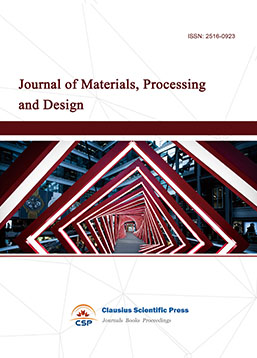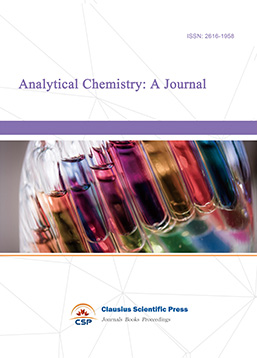MIGRATION AND DEGRADATION BY VOLATILE COMPOUNDS FROM SCENT LEAF (Ocimum gratissimum) ON POLYETHYLENE TEREPHTHALATE PACKAGED WATER
DOI: 10.23977/chepp.2021.010101 | Downloads: 40 | Views: 4331
Author(s)
Orodu Victor Enearepuadoh 1
Affiliation(s)
1 Department of Chemical Sciences, Faculty of Science. Niger Delta University, Wilberforce Island, P.M.B 071, Bayelsa State
Corresponding Author
Orodu Victor EnearepuadohABSTRACT
Migration and degradation by volatile compounds from scent leaf (ocimum gratissimum) on polyethylene terephthalate packaged water was studied using dichloromethane for extraction(solvent extraction) of the analyte from water packaged in polyethylene terephthalate. GC-MS was used to quantify the components. A total of 24 compounds were identified and quantified in the experiment which included: 3 hydrocarbons, 1 polycyclic aromatic hydrocarbon, 5 alcohols, 2 ketones , 4 phthalate, 6 esters, and 3 organic acids. The amount of diisobutyl phthalate(2.20%) followed by 2- decanol (0.00992%), triethyl citrate (0.0429%), hexanedioic acid (0.0264%), 4 – dodecene-6,8,10-triyn-one (0.00233%), squalene (0.0184%) and pyrene (0.0106%). Nitrogen was the only component found in the control, since it was not stored with the scent leaf (ocimum gratissimum) . The result showed that polyethylene terephthalate are degraded by volatiles from plants. Hence, bottled and sachet water should be stored separately in homes,offices laboratories etc.
KEYWORDS
Scent leaf (Ocimum gratissimum), Degradation, Migration,GC/MSCITE THIS PAPER
Orodu Victor Enearepuadoh, MIGRATION AND DEGRADATION BY VOLATILE COMPOUNDS FROM SCENT LEAF (Ocimum gratissimum) ON POLYETHYLENE TEREPHTHALATE PACKAGED WATER. Chemistry and Physics of Polymers (2021) Vol. 1: 1-11. DOI: http://dx.doi.org/10.23977/chepp.2021.010101.
REFERENCES
[1] Addulrahman G. (1992).Medicinal plants and traditional medicine in Africa: Spectrum Books Ltd. Journal of essential oil of research: 8, 139-141.
[2] Adewole, K. (2014). Proximate and Phytochemical constituents of Ocimum gratissimum.African Journal of Biotechnology.4(7):685-688.
[3] Alhassan Muhammad M. and Ujoh Fanan (2012) Assessment of the Chemical Quality of Potable Water Sources in Abuja, Nigeria, British Journal of Applied Science & Technology 2(2): 146-172.
[4] Amiridou D., Voutsa D. (2011), Alkylphenols and phthalates in bottled waters. Journal hazardous materials: 185(1): 281-286.
[5] Amobi, G., Zenobi, R., and McGuigan. (2007). Determination of water in polythene bags made of synthetic petroleum. Journal of Research and Technology, 90(4): 278-283.
[6] Bach, C., Dauchy, X., and Etienne, S. (2009). Characterization of poly(ethylene terephthalate) used in commercial bottled water. Materials Science and Engineering, 5(1):5 – 10.
[7] Dada, A.C (2009). Sachet Water phenomenon in Nigeria: Assessment of the potential health impacts. African Journal of Microbiology Research, 3(1), 015-021, Available online http://www.academicjournals.org/ajmr.
[8] Daniel, S., Rusell, A.A. and Furr, J.R. (2011).The phytochemical analysis and mineral elements composition of Ocimum basilicumObtained in Jos Metropolis, Plateau State, Nigeria.Journal of Applied Bacteriology. 43:253-260.
[9] Darrah, H.H. (1998). The cultivated Basil. Buckeye Printing. Independence, MO.
[10] Edeoga H. O., Eriata D.O. (2001): Alkaloids, Tannins and contents of some Nigerian medicinal plants: Journal of medicinal aromatic plants science; 23, 21-25.
[11] Effraim K. D, Jacks T. W and Sodipo O. A. (2003): Histopathological studies on the toxicity of Ocimum gratissimum leave extract on some organs of Rabbits: African Journal of biomedical research; 6. Pg. 21-25.
[12] Esvanszhuga G. (1980): The chemical constituent of Ocimum gratissimum: African Journal of Biotechnology.4(7):685-688.
[13] Farhoodi, M., Emam – Djomeh, Z., Ehsani, MR., and Oromiehie, A. (2008). Effect of environmental conditions on the migration of di(2-ethylhexyl)phthalate from PET bottles into yogurt drinks: influence of time, temperature and food stimulant. Arabian J, Sci Eng 33(2) : 279 – 287.
[14] Freire, C.M., M. O. Marques, and M. Costa.( 2006). Effects of seasonal variation on the central nervous system activity of O. gratissimum L. essential oil. J. of Ethnopharmacology 105:161-166.
[15] Grayer, R.J., G. C. Kite, F.J. Goldstone, S.E. Bryan, A. Paton., and E. Putievsky. 1996. Infraspecific taxonomy and essential oil chemotype in sweet basil, Ocimum basilicum. Phytochemistry 43:1033-1039.
[16] Guler Cuneyt , Alpaslan Musa (2009) Mineral content of 70 bottled water brands sold on the Turkish market: Assessment of their compliance with current regulations, Journal of Food Composition and Analysis22: 728–737.
[17] Ijeh I. I, Njoku O. U., Ekenza E. C. (2004): Medicinal evaluation of Xylopia aethiopica and Ocimum gratissimum: Journal of medicinal aromatis science; 26 (1): 44-47.
[18] Iwu, W.(1993).Bergey’ Manual of Determinative Bacteriology.8th edn.Williams and Wilkin Co., Baltimore. African Journal of Biotechnology.4(7):685-688.
[19] Latva, M.; Kaunisto, T.; Pelto-Huikko, A.( Latva, M.; Kaunisto, T.; Pelto-Huikko, A.(2017) Durability of the non-dezincification resistant CuZn40Pb2 brass in Scandinavian waters. Eng. Fail. Anal., 74, 133–141.]
[20] Latva, M.; Inkinen, J.; Rämö, J.; Kaunisto, T.; Mäkinen, R.; Ahonen, M.; Matilainen, J.; Pehkonen, S(2016). Studies on the magnetic water treatment in new pilot scale drinking water system and in old existing real-life water system. J. Water Process. Eng., 9, 215–224
[21] Lawrence, B.M. (1993). Labiatae oils: Mother nature’s chemical factory. In: Essential oils. Carol Stream, IL: Allured Publishing. 188-206.
[22] Lena, D., Skush, Y. (2007). Suggestion of plastic bottle used in water soda and the release of bisphenol A”. Envinron. Int. (36): 557-562
[23] Lin, J., and Huang, S. K. (2000). Studies on curing kinetics on total thermal degradation of the modified epoxy copolymer with penta-coordinated phosphate as a tribranched junction. Journal of Applied Polymer Science. 77(4): 719 – 732.
[24] Mufeed I. (2006). The quality of portable water types in Jordan. Environmental monitoring and Assessment, 117: 235-244.
[25] Musa Umaru, Aliyu Musa A, Sadiq Muhammad. M, Mohammed Ibrahim. A, Manase Auta and Mustapha D.I(2014a) Quality Assessment of Sachet Water in Minna Metropolis of Niger State, Nigeria, Proceedings of 44th Annual Conference, Exhibition of Nigerian Society of Chemical Engineers (NSChE), 20-22.
[26] Musa Umaru, MohammedIbrahim Aris,Muazu Sagir Y.& Bala, Alhaji (2014b)Quality Assessment of Treated Water Supply: A Case Study of Minna, Nigeria, Journal of Science, Technology, Mathematics and Education (JOSTMED),10(2): 56-62.
[27] Mutsuga, M., Kawamura, Y., Sugita-Konishi, Y., Hara-kudo, Y., Takatori, K., and Tanamoto, k. (2006). Migration of formaldehyde and acetaldehyde into mineral water in polyethylene terephthalate (PET) bottles. Food Additives and Contaminants. 23(2):212-218.
[28] Nawrocki, J., Dabrowska, A., and Borcz, A., (2002). Investigation of carbonyl compounds in bottled water from Poland. Water Research 36(19): 4893 – 4901.
[29] Ndinwa C.C.G., Chukumah O.C., Edafe E.A., Obarakpor K.I., Morka W., P.N. Osubor-Ndinwa, (2012).Journal of Environmental Management and Safety. 3(2) 145 –160.
[30] Olaoye O.A and Onilude, A.A. (2009) Assessment of microbiological quality of sachet-packaged drinking water in Western Nigeria and its public health significance. Public Health. 123(10): 729–734
[31] Oliver M. (1980): The chemical constituent of Ocimum gratissimum: African Journal of Biotechnology. 4 (7):685-688.
[32] Onweluzo, J. C. and Akuagbazie, C.A (2010): Assessment Of The Quality Of Bottled And Sachet Water Sold In Nsukka Town.Agro-Science Journal of Tropical Agriculture, Food, Environment and Extension. 9(2): 104 –110.
[33] Orodu V.E, Inengite A.K and Wankasi D(2017): A Preliminary study of the migration of volatile components from crushed garlic (allium sativum) into polyethylene, terephthalates packaged water. Scholars Academic Journal of Biosciences. . 5(7):519-524
[34] Osifo K. (1992): Medicinal plants and traditional medicine in Africa: Spectrum Books Ltd. Journal of essential oil of research: 8, Pg. 139-141.
[35] Oyelude, E. O and Ahenkorah S (2012) Quality of Sachet Water and Bottled Water in Bolgatanga Municipality of Ghana.Research Journal of Applied Sciences, Engineering and Technology 4(9): 1094-1098.
[36] Paton, A., R.M. Harley, and M.M. Harley. 1999. Ocimum. Medicinal and Aromatic Plants. 11. Amsterdam: Harwood Academic. 166p.
[37] Pelto-Huikko, A.; Ahonen, M.; Ruismäki, M.; Kaunisto, T.; Latva, M. (2021)Migration of Volatile Organic Compounds (VOCs) from PEX-a Pipes into the Drinking Water during the First Five Years of Use. Materials, 14, 746. https://doi.org/10.3390/ma14040746
[38] Pino J. A., Rosada A., Fuestes V. (1996). Composition of the essential oils from the leaves and flowers of ocimum gratissimum L. grown in Cuba: Journal of essential oil of research: 8, Pg. 139-141.
[39] Rusz, H, Spiros, A., and Pergantis. (2006). Detection of antimony species in citrus juice and drinking water stored in PET containers.Anna J. At. Spectrom., 21, 8 : 731 – 736.
[40] Schmida, P., Kohlerb, M., Meierhofec, R., Luzic, S., and Wegelinc, M. (2008). Does the reuse of PET bottles during solar water disinfection pose a health risk due to the migration of plasticisers and other chemicals into the water.WaterResearch,42:5054—5060.
[41] Sharkey T.D.,Yeh S.(2001). Isoprene emission from plants. Annual Review of plant physiology and plant molecular biology. Journal of essential oil of research: 8, Pg. 139-141.
[42] Sofowara E.A. (1993): Medicinal plants and traditional medicine in Africa: Spectrum Books Ltd. Ibadan, Nigeria. Journal of essential oil of research: 8, Pg. 139-141.
[43] Sulaiman G. Muhamad, Lawen S. Esmail, Shelear H. Hassan(2011). Effect of storage temperatureand sunlight exposure on the physiochemical properties of bottled water in Kurdistan Region-Iraq. Arabian Journal Chemistry, 15(1): 147-154
[44] Wagner J. (1999). Isoprene emission from plants. Annual Review of plant physiology and plant molecular biology. Journal of essential oil of research: 8, Pg. 139-141.
[45] Wegelin, M., Canonica, S., Alder, A.C, Marazuela, D., Suter, M.J..- F., Bucheli, T.D., Haefliger, O.P., Zenobi, R., McGuigan, K.G., Kelly ., M.T., Ibrahim, P. and Larroque, M. (2001). Does sunlight change the material and content of polyethylene terephthalate (PET) bottle.Journal of Water Supply: Research and Technology, Acqua. 50(3): 125-133.
[46] Yanagimoto, K., Lee,K.G., Ouchi, H and Shibamoto, T. (2002). Antioxidative activity of heterocyclic compounds formed in maillard reaction products. J. Agric and Food chem . 50; 5480 – 5484.
| Downloads: | 40 |
|---|---|
| Visits: | 4331 |
Sponsors, Associates, and Links
-
Forging and Forming

-
Composites and Nano Engineering

-
Journal of Materials, Processing and Design

-
Metallic foams

-
Smart Structures, Materials and Systems

-
Analytical Chemistry: A Journal

-
Modern Physical Chemistry Research

-
Inorganic Chemistry: A Journal

-
Organic Chemistry: A Journal

-
Progress in Materials Chemistry and Physics

-
Transactions on Industrial Catalysis

-
Fuels and Combustion

-
Casting, Welding and Solidification

-
Journal of Membrane Technology

-
Journal of Heat Treatment and Surface Engineering

-
Trends in Biochemical Engineering

-
Ceramic and Glass Technology

-
Transactions on Metals and Alloys

-
High Performance Structures and Materials

-
Rheology Letters

-
Plasticity Frontiers

-
Corrosion and Wear of Materials

-
Fluids, Heat and Mass Transfer

-
International Journal of Geochemistry

-
Diamond and Carbon Materials

-
Advances in Magnetism and Magnetic Materials

-
Advances in Fuel Cell

-
Journal of Biomaterials and Biomechanics


 Download as PDF
Download as PDF